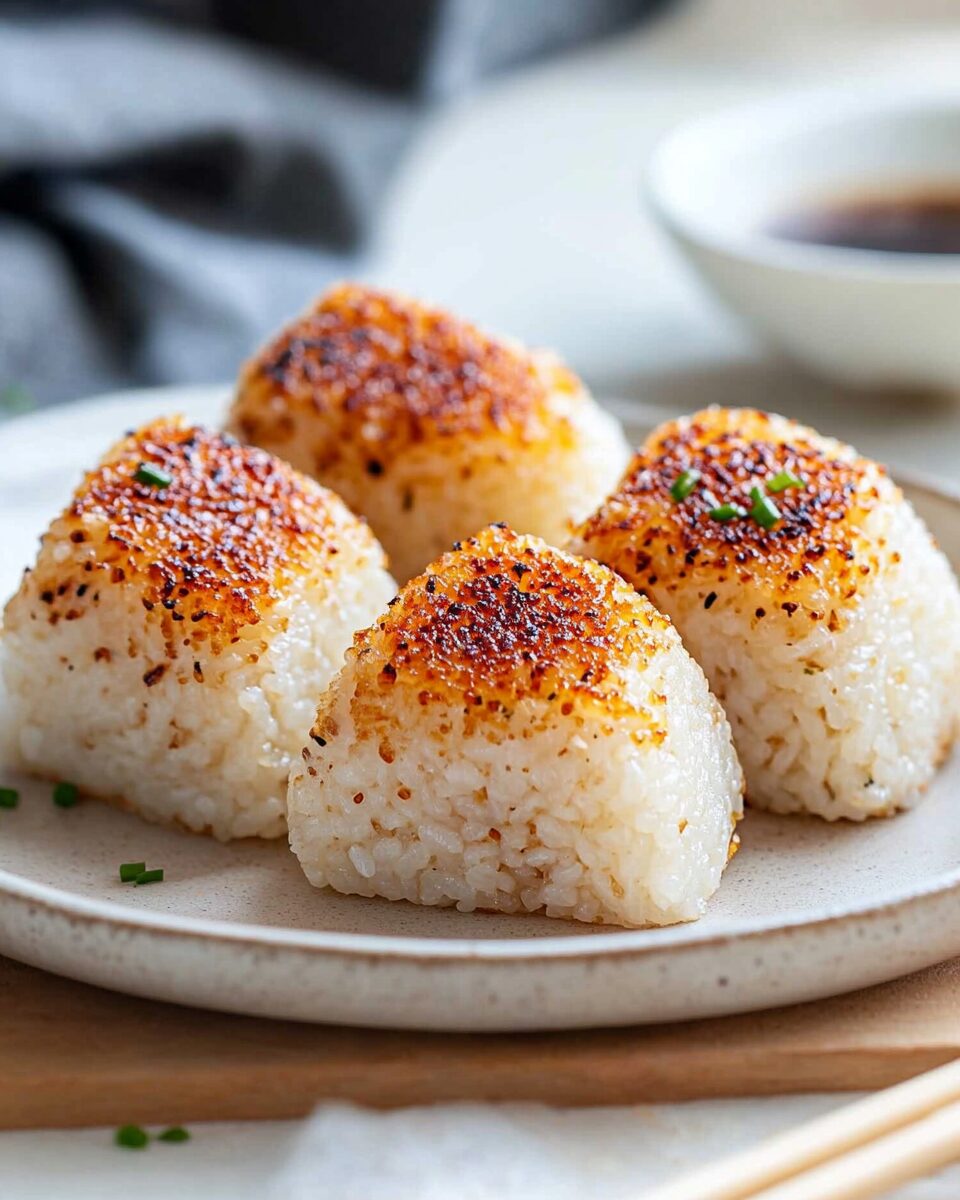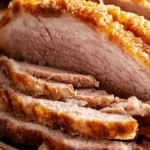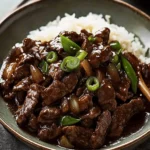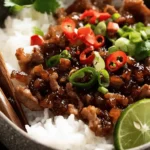Yaki Onigiri, or grilled rice balls, are a delicious Japanese dish made from rice balls that are crisped up on the grill or in a pan. These savory rice treats are often coated with soy sauce and can be filled with ingredients like pickled plum or salmon, making them a perfect snack or side dish.
FULL RECIPE
Ingredients
- 2 cups cooked short-grain rice
- 1 tablespoon soy sauce
- 1 teaspoon mirin (optional)
- 1 teaspoon sesame oil
- 1 tablespoon vegetable oil (for grilling)
- Salt (to taste)
Directions
- Let the cooked rice cool to room temperature.
- Lightly oil your hands with sesame oil and form the rice into small triangular or round balls.
- Brush the rice balls with a small amount of soy sauce and mirin (if using).
- Heat a pan or grill over medium heat, adding a little vegetable oil.
- Place the rice balls on the grill or in the pan and cook for 3-4 minutes per side, until golden brown and crispy.
- Remove from heat and sprinkle with a pinch of salt.
- Serve immediately, and enjoy your crispy, savory rice balls!
Nutritional Information
- Calories: 200-250 kcal per rice ball
- Carbohydrates: 40g
- Protein: 4g
- Fat: 4g
- Sodium: 300-400mg
History of Yaki Onigiri
Yaki Onigiri has a long-standing place in Japanese culinary tradition. It is believed to have originated during the Edo period (1603-1868), when rice was a staple food for many Japanese households. The practice of grilling rice balls evolved as a way to preserve leftover rice. The toasted exterior helped protect the rice from spoiling, and the savory soy sauce coating added flavor. Over time, this simple but effective method became popular as a portable and easy meal or snack.
Why Yaki Onigiri is So Popular
Yaki Onigiri’s popularity can be attributed to its simplicity and versatility. The rice balls can be prepared with minimal ingredients and can be customized to suit a variety of tastes. In Japan, they are often sold at convenience stores and enjoyed as a quick snack or lunch. The grilling process gives the rice balls a crispy and deliciously smoky flavor, which is a key part of their charm.
Different Variations of Yaki Onigiri
Though the basic concept of Yaki Onigiri remains the same, there are many variations of this dish. Some versions feature fillings such as salmon, pickled plum (umeboshi), or even grilled vegetables. The type of soy sauce or seasoning used may also vary, with some recipes calling for teriyaki sauce or miso paste for a unique flavor profile. These variations allow for personalization, making Yaki Onigiri a dish that can suit many different tastes.
Choosing the Right Rice for Yaki Onigiri
For Yaki Onigiri, it is important to use short-grain rice, which is sticky and holds together well when forming the rice balls. This sticky rice texture ensures that the rice balls do not fall apart while grilling. Japanese short-grain rice is ideal, but any medium-grain rice that can stick together will work. Avoid using long-grain rice, as it tends to be drier and less sticky.
The Grilling Technique
Grilling is a crucial aspect of Yaki Onigiri. The process of grilling gives the rice balls their crispy exterior, which contrasts beautifully with the soft, tender rice inside. While traditional methods use an open flame or grill, a stovetop pan or even an oven can also be used to achieve the desired result. It is important to flip the rice balls carefully to avoid breaking them and to ensure they cook evenly on all sides.
How to Serve Yaki Onigiri
Yaki Onigiri can be served in a variety of ways. In Japan, they are often enjoyed with a side of pickled vegetables, miso soup, or a simple salad. The grilled rice balls can also be served as part of a bento box, providing a delicious and filling meal. In more casual settings, they make an excellent snack or appetizer that can be shared among friends or family.
The Role of Soy Sauce in Yaki Onigiri
Soy sauce plays an important role in the flavor profile of Yaki Onigiri. It is often brushed onto the rice balls before grilling, giving them a savory and umami-packed glaze. The soy sauce caramelizes as the rice balls cook, creating a crispy, flavorful exterior. Depending on the recipe, soy sauce can be used alone or combined with other ingredients such as mirin or sesame oil for added depth of flavor.
Using Mirin for a Sweet Touch
Mirin, a sweet rice wine, is often added to the soy sauce when preparing Yaki Onigiri. The combination of mirin and soy sauce creates a balanced flavor, with the sweetness of the mirin contrasting with the saltiness of the soy sauce. This mixture enhances the overall taste of the rice balls and gives them a slightly glossy finish. While mirin is optional, it is a popular addition in many Yaki Onigiri recipes.
Making Yaki Onigiri Vegan
While traditional Yaki Onigiri may include ingredients like fish or meat, it is easy to make the dish vegan by simply omitting animal-based fillings. You can fill the rice balls with vegetables such as grilled mushrooms, spinach, or even avocado for a fresh, plant-based alternative. Additionally, using a plant-based soy sauce or miso will ensure that the dish remains fully vegan.
Health Benefits of Yaki Onigiri
Yaki Onigiri can be a healthy meal or snack when prepared with wholesome ingredients. The rice provides a good source of carbohydrates, which are essential for energy. If you add vegetables or fish as a filling, you increase the nutritional value by adding vitamins, minerals, and protein. The use of sesame oil and other healthy fats can also provide beneficial omega-3s. While it’s important to be mindful of the sodium content from soy sauce, Yaki Onigiri can be a balanced dish when enjoyed as part of a healthy diet.
Gluten-Free Options for Yaki Onigiri
For those with gluten sensitivities or celiac disease, it is important to choose a gluten-free soy sauce or tamari when making Yaki Onigiri. Many commercially available soy sauces contain wheat, but tamari is a great alternative that provides the same savory flavor without gluten. With this simple substitution, Yaki Onigiri can easily be made gluten-free, allowing those with dietary restrictions to enjoy this dish.
Pairing Yaki Onigiri with Beverages
Yaki Onigiri pairs well with a variety of beverages. In Japan, it is often enjoyed with green tea, which complements the savory and slightly sweet flavor of the rice balls. You can also pair Yaki Onigiri with chilled sake or beer for a more casual experience. For a non-alcoholic option, iced tea or lemonade can provide a refreshing contrast to the richness of the dish.
Making Yaki Onigiri for a Crowd
If you’re preparing Yaki Onigiri for a group or gathering, it’s easy to make large batches of rice balls. You can form the rice balls in advance and store them in the refrigerator until you’re ready to grill them. This makes them a convenient option for parties, picnics, or barbecues. When grilling for a crowd, ensure that the grill or pan is large enough to accommodate multiple rice balls at once, and be sure to rotate them often for even cooking.
Customizing Yaki Onigiri with Fillings
Yaki Onigiri can be filled with a wide range of ingredients. Traditional fillings include grilled salmon, pickled plum (umeboshi), or ground meat, but the possibilities are endless. Some people enjoy adding a bit of cheese, sautéed vegetables, or even kimchi for a fusion twist. Experimenting with different fillings allows you to tailor the dish to your taste and make it unique each time you prepare it.
Using Leftover Rice for Yaki Onigiri
Yaki Onigiri is an excellent way to repurpose leftover rice. Instead of throwing away extra rice from previous meals, you can transform it into a delicious snack or meal by making Yaki Onigiri. The rice can be stored in the fridge for a day or two and still be used to create crispy, flavorful rice balls. This is a great way to minimize food waste while enjoying a tasty dish.
Storing Yaki Onigiri
If you have leftover Yaki Onigiri, they can be stored in an airtight container in the refrigerator for up to two days. To reheat, place them in a dry pan over medium heat, turning them occasionally until heated through and crispy again. You can also freeze the rice balls for longer storage, but be sure to wrap them tightly before freezing to prevent freezer burn.
The Appeal of Yaki Onigiri in Japanese Cuisine
Yaki Onigiri is beloved in Japanese cuisine for its simplicity, versatility, and nostalgic value. It brings together the fundamental elements of Japanese cooking: rice, soy sauce, and grilling. The dish evokes memories of picnics and outdoor gatherings, making it an iconic comfort food in Japan. Whether served as a snack, part of a meal, or at a celebratory occasion, Yaki Onigiri remains a staple of Japanese food culture.
Advertisement
Cultural Significance of Yaki Onigiri
In Japan, Yaki Onigiri is more than just a dish; it is a cultural symbol of practicality and resourcefulness. During times of war or hardship, people would often make use of leftover rice, which could easily be grilled over an open fire. This clever method of preservation turned an ordinary ingredient into something special. Today, Yaki Onigiri continues to carry this sense of simplicity and ingenuity, making it a cherished food across generations.
Yaki Onigiri in Popular Media
Yaki Onigiri has also made appearances in various forms of popular media, including anime and manga. It is often depicted as a comforting meal enjoyed by characters during moments of relaxation or togetherness. This portrayal further solidifies its status as a beloved, homey dish that transcends generations and resonates with people around the world.
Conclusion
Yaki Onigiri is a timeless Japanese dish that combines simplicity with delicious flavors. Whether enjoyed as a quick snack, part of a meal, or as a creative platform for various fillings, these grilled rice balls offer a satisfying and customizable culinary experience. With its rich history, versatility, and cultural significance, Yaki Onigiri remains an enduring favorite among food enthusiasts around the globe.






